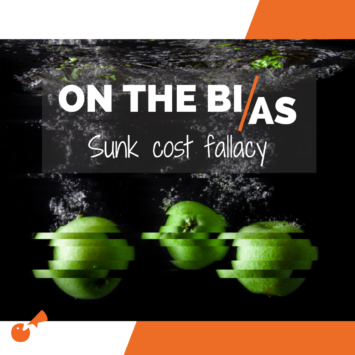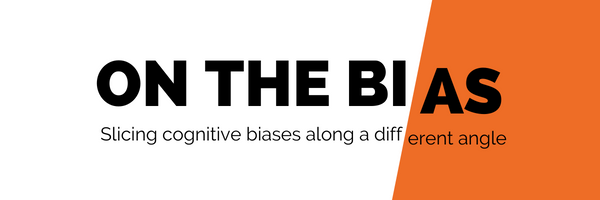
ON THE BIAS: Sunk Cost Fallacy
Welcome back to the blog series, ON THE BIAS.
In this series, we look at the cognitive biases we have as humans and how they impact our behavior change efforts. Catch up with the previous posts here.

A story: That dang dresser again.
Do you remember the dresser I talked about during the first On the Bias post on the IKEA effect?
You can read it here if you don’t remember or weren’t receiving these emails at that time.
In that post, I shared that it took two hours for my dad and I to build the “some assembly required” dresser I bought online, which is why I have a strong emotional attachment to it.
Another part of that story is that 45 minutes into building the dresser plank by plank, my dad started to get kind of annoyed. He looked around at all the material we still had left to assemble and said, “Aren’t you at the point in your life and career that you can buy a sturdy, assembled dresser and have it delivered?”
Clearly, he was not appreciating my frugal nature!
He also wasn’t entirely wrong. I could have opted to spend a little more money in exchange for quality and convenience.
But I had already spent money on this dresser, AND we had already finished the main frame of the structure.
There was no way I was going to “go backward” and start the dresser-buying process all over again. The only option was to press onwards and finish the project we started.
What’s happening here?
My unwillingness to switch gears and buy a different dresser, or even consider it a realistic option, due to having already invested time and money into the current dresser, is emblematic of the sunk cost fallacy.
ON THE BIAS: We commit the sunk cost fallacy when “we are likely to continue an endeavor if we have already invested in it, whether it be a monetary investment or the effort we put into the decision. That often means we go against evidence that shows it is no longer the best decision” (The Decision Lab).
In more colloquial terms, it describes those moments when we decide to double down instead of cut bait, even though – deep down inside – we know we should pivot.
We push ahead because the alternative of stopping or switching feels like we have wasted the time, effort, and money already invested (hence, the “sunk costs”) even when it is the more rational decision.
When we commit the sunk cost fallacy, we let past decisions guide future direction.
Bringing the bias home: Reflect on a project or a situation you invested time, effort, or money into that reached a juncture where a better alternative presented itself.
Your example could be a minor circumstance, like deciding to attend a concert or movie even though you weren’t feeling up to it (or the weather was bad), simply because you had already purchased the ticket. Or, it could be more significant, like staying in a bad job because of the time and effort you’ve already put into it.
In these situations, how much did the sunk costs influence your next step? What would it have looked like to ignore the sunk costs as a factor in your decision?
A nuance of sunk costs is that pressing forward doesn’t always result in bad news.
Maybe the concert or movie you attended was worth the extra effort to get there. I’ve had my dresser for a decade, and I’m still pleased with it, even though investing in a sturdier piece of furniture would have been a smarter (and more sustainable) choice.
There may be a good reason to press forward. But when we fall victim to the sunk cost fallacy, we only think about what we’ve invested and not about the potential benefits ahead, which clouds our ability to weigh the pros and cons at crucial junctures.
How this bias can help or hurt our behavior change programs
HOW IT CAN HURT
Let’s put ourselves in our audiences’ shoes.
Many of them have invested time, effort, and money into their current habits and systems, even if they are not the most sustainable or time and cost-efficient.
They already spent money on gas-powered cars and lawn equipment. They have a routine in their household that uses a set amount of energy, water, and food. They’ve found the best route to work that takes the least amount of time. They saved enough to finally book that overseas vacation they’d been dreaming about for years.
And here we come, advising them to change.
This pushes the audience to decide whether they are willing to let go of their sunk costs and adopt a more sustainable (and healthier, and more cost-efficient, etc.) path forward or if they will double down on their current behaviors.
The sunk cost fallacy helps us understand how audiences struggle with deciding to make a change. They feel an innate pull to consider everything they’ve invested up to this point in their lives and a strong desire not to feel like they wasted that time, effort, and money.
Thankfully, the behavioral and social sciences also give us solutions for supporting audiences with making lifestyle changes.
» Start with a trial or a small first step.
Instead of asking audiences to completely move away from their current patterns, which will trigger the sunk cost fallacy, we can encourage them to start with one small step (e.g., electrify one piece of lawn equipment) or explore an alternative to see how it feels (e.g., try Meatless Mondays for a month).
» Align the new behavior with the fresh start effect.
It can sometimes be easier to make a lifestyle change during key milestones, like the start of a new year or season. We can coordinate our projects with these moments when audiences feel mentally prepared for a “fresh start” and are willing to let go of previous decisions and habits.
» Reframe it as part of a learning process.
The sunk cost fallacy emerges when audiences feel they must leave behind and “lose” their previous investments. We can decrease the intensity of these feels by focusing on the longer journey of change we’re all traveling through and not shaming the audience for their previous actions.
HOW IT HELPS
This bias can also work in our favor, especially for audience members who have already started on their journey of change.
Making a lifestyle change is hard, and there will likely be times when the audience will want to give up and quit. During these rough patches in the journey, we can be cheerleaders for our audience and remind them of all the hard work and effort they put in so far. “You’ve made it this far – let’s keep going!”
Having the ability to showcase the progress and impact they’ve made to date can highlight their investment and encourage them to keep moving forward.
These scenarios are also an opportunity to remind the audience of the longer journey so they are not discouraged by temporary setbacks and can see the path ahead.
A NOTE OF CAUTION
Sunk cost fallacies impact us as behavior change program managers, too.
We should be mindful not to stubbornly pursue strategies, interventions, and approaches that don’t have a clear path to success.
At critical junctures in projects, examine if the team is doubling down on an approach because of sunk costs when, instead, you should be looking to pivot to a better option.
Want to sink into the world of sunk costs? Check out these published papers on the topic:
- Arkes, H. R., & Blumer, C. (1985). The psychology of sunk cost. Organizational behavior and human decision processes, 35(1), 124-140.
- Ronayne, D., Sgroi, D., & Tuckwell, A. (2021). Evaluating the sunk cost effect. Journal of Economic Behavior & Organization, 186, 318-327.


